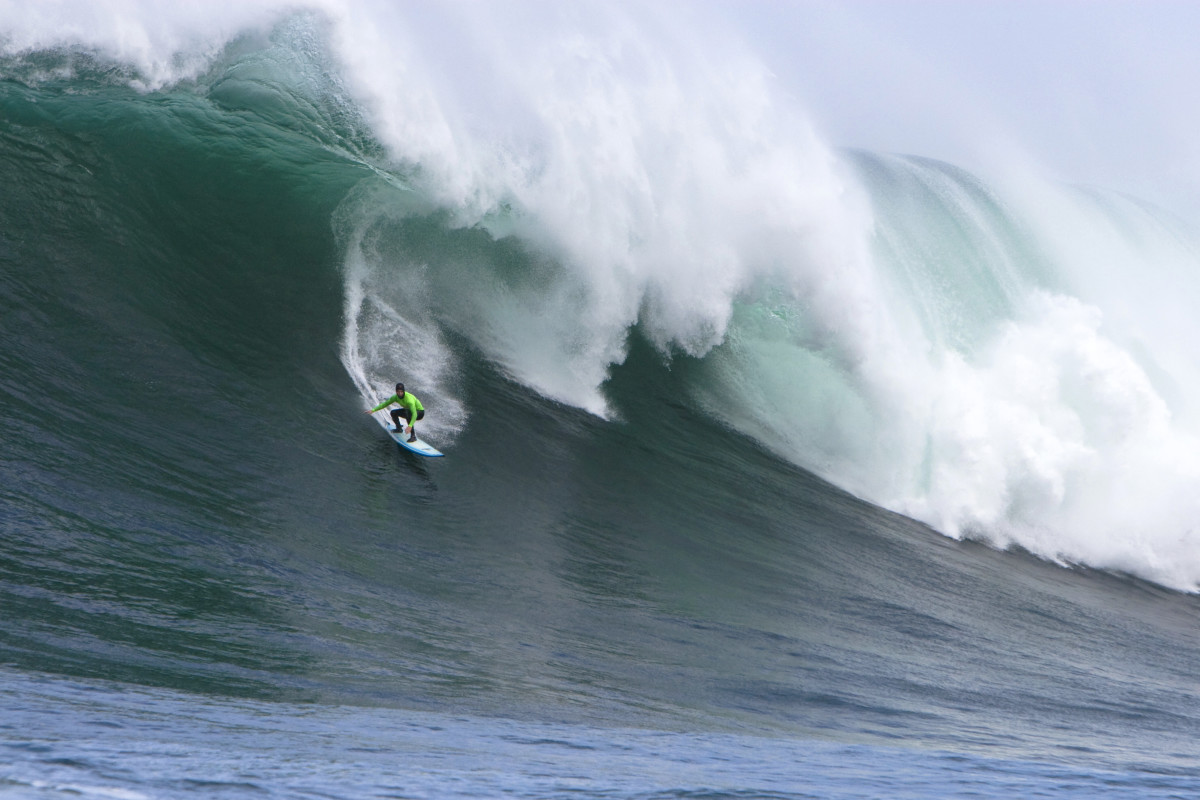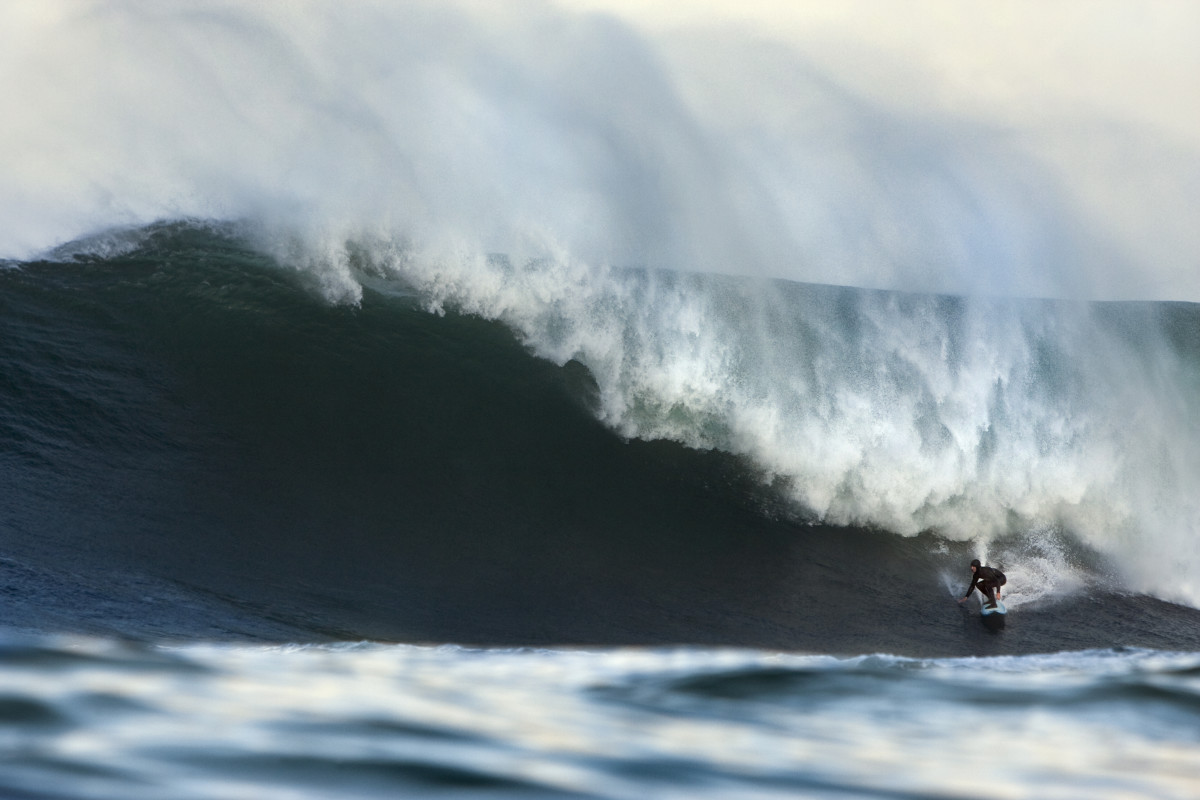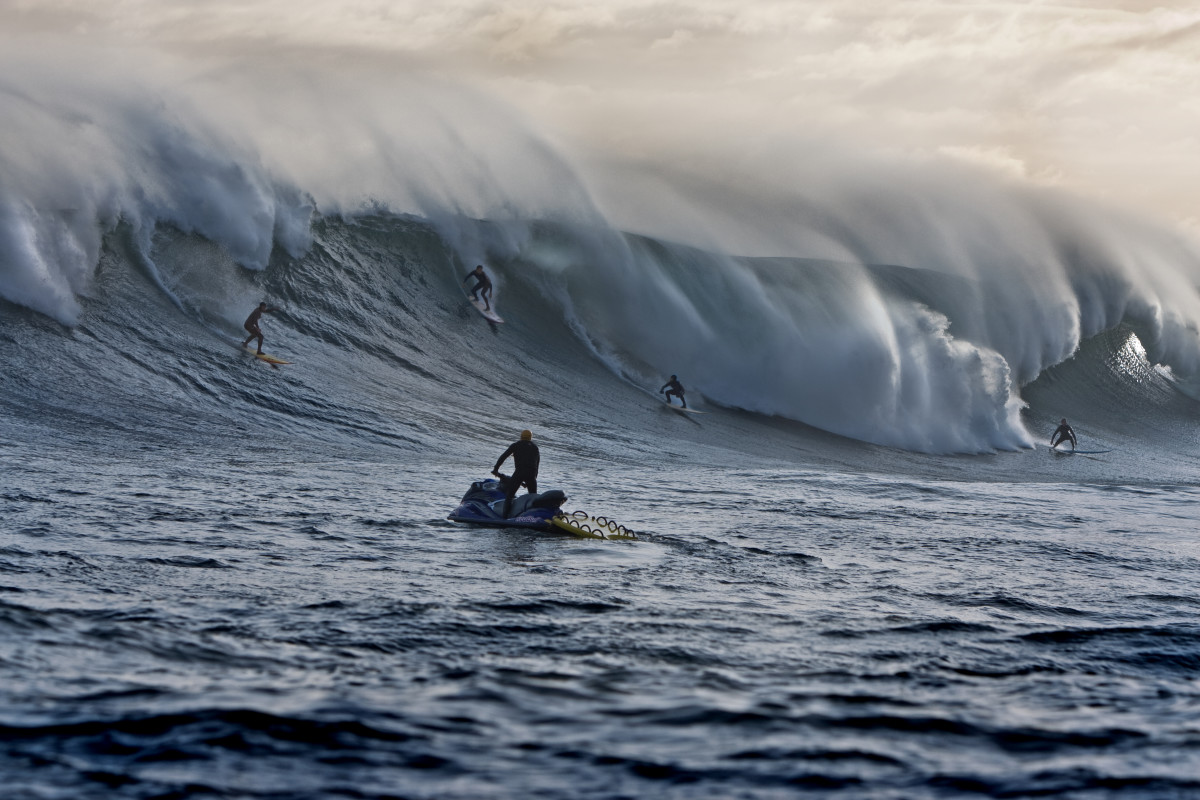
Photo: Alan van Gysen/Red Bull Content Pool
It took a while for the world to comprehend what could be surfed and couldn’t. A watershed moment would have been the Millenium Wave, the first guys to paddle Jaws, the discovery of Nazaré, and the progressive slab surfing of Ours and Shipstern Bluff.
Growing up in Cape Town in the 1980s, we had all seen Dungeons, but for young groms, it was an impossible wave to surf in so many ways. We sometimes watched it from Chapman’s Peak in screaming south easterlies after a session at The Hoek, refueling and pondering what couldn’t be.
Firstly, there was no way to get there. It was a deep water break, sitting off the Sentinel Mountain, and there was no way around the mountain to the base of the cliff for a possible paddle out.
The route over the top meant you would need to park in and walk through the Hangklip township. Back in the ‘80s, this was an impossibility. We were kids at school or at University. We all had one thing hanging over us like a Sword of Damocles: the dreaded two years of national service. The political climate was volatile. The riots of 1985 revealed just how deep South Africa was in the shit. The Los Angeles Times reported thus: Riots, Fires Spread Near Cape Town: Police, Blacks in Running Battles; 2-Day Toll Is 21. At the same time (1985), the ASP rolled into town for the Spur Steakrach Surfabout, but with a few surfers missing due to boycotts.
But a year earlier, unbeknown to us, Dungeons had already been ridden.
Two older surfers sat on the very same Chapmans Peak Drive where we used to watch Dungeons. Across the bay, they could see the massive right-hander spinning off in the distance. Even from that far away, the giant Dungeons barrel could be seen a few miles across open water. And they considered it.
Without a quick rubber duck ride to the line-up, without rescue skis in the channel ready to haul them out of danger, without cellphones. Without much chance of rescue should there be a mishap, and without the understanding that the solid slab of heaving water was actually rideable, they thought about it.
Their only knowledge was that they would be the first to surf it and that great white sharks were harboring in the deeps. The thousands of seals on Duiker Island were a testament to this. Yet despite all this and the mammoth accessibility task to the line-up, they weighed it up. Then, one day, they decided to hit it.
Pierre de Villiers and his good friend Peter Button were the first to surf Dungeons, then simply known as The Sentinel, from the description of the rock structure overlooking the wave all those years ago. Other surfers have subsequently laid claims that they surfed it first, but Peter and Pierre couldn’t care less.
“The first time we surfed Sentinel was in nineteen eighty-four,” remembers Pierre. “We checked it out for about a year, trying to puzzle it out. At that stage, we were obviously pretty nervous.”

Photo: Caleb Bjergfelt/Red Bull Content Pool
Back then, surfing big waves was a different ballgame. It was more complex and grittier. There wasn’t a big wave renaissance in the air. There was no media hype. There was no general interest. There were just surfers feeling an inherent pull toward giant waves. The equipment wasn’t refined, and the knowledge and experience regarding big-wave surfing were limited.
“There used to be an old rubbish dump at the top of the village on the base of the mountain in Hout Bay, and we used to park our car there, climb over the mountain, paddle out and walk back,” remembers Pierre. It was an all-day mission. The climb was challenging; it took an hour, and the paddle was a good twenty minutes. I wouldn’t do it now. The first time we surfed it was the winter of 84. I was working for Jonathan (Paarman), spraying boards at his factory at the bottom of town, and we didn’t know anyone surfing it. People had checked it out. There wasn’t any real story of people surfing. It was all very vague.”
Related: Navigating South Africa’s Scariest Big Wave, with Grant “Twiggy” Baker
Peter, who now lives in Australia, fondly remembers those hazy days. “I think it was back in 1984 when we went up to the mountain ridge overlooking it to check it out a couple of times. The wave looked exceptional and awesome,” said Peter in an interview with Zigzag Magazine. “We decided that it looked possible.”
So they paddled out for the first time into the history books. “It was a Tuesday afternoon, gray, misty, a little glassy, probably about 12-foot plus, and very light offshore. I remember us working out the best place to leap into the unknown from the boulders, paddling across the deep gully, and the powerful stench from the island teeming with seals. We carefully paddled around the peak to the south of the reef – and then realized that our boards were inappropriate. I think I had about a 5’8″ thruster, and Pierre, I think, had either his 5′ something twin-fin or a four-fin number.”
“It was 5’4″” remembers Pierre.
These were not ideal boards for the waves, considering the equipment used today for paddling the big stuff, so Peter and Pierre experienced some difficulties.
“I remember scratching over a dredging large set wave as we got out there, looking down at Pierre about to get smoked, and then not seeing him for 10-15 minutes. I remember it was not easy to get in again – timing it right to come up the boulders again.”
The duo continued hunting down the big stuff, attempting Dungeons a few times and working on equipment. In these heady days of big wave surfing in Cape Town, there was very little going on in the global big wave arena apart from Hawaii. Jaws hadn’t been surfed yet, Teahupo’o had yet to show her face, and Jeff Clark kept Mavericks under wraps.
“Subsequent surfs became easier as we became familiar with the setup,” recalls Peter. “We always got waves, but our equipment made it difficult to take off deep. I think it was usually in the 12-18 foot range. I remember surfing Sunset bigger, but Hout Bay was better. Sunset did get pretty good, though. And we still had difficulty convincing anyone else that there were these top-quality large waves in Cape Town.”

Photo: Caleb Bjergfelt/Red Bull Content Pool
Jump forward to 2000 and the first Dungeons, Red Bull Big Wave Africa event. The contest is run off in 12 to 15-foot waves. There is excitement and exuberance and an undercurrent of the thrill of discovery, of climbing Everest. Pierre and Peter are not around. Pierre isn’t into contests, and Peter is in Australia. Their influence is primary regarding the evolution of Dungeons as a surf spot, yet their involvement is negligible.
“There is a whole world of surfing out there,” said Pierre in an interview with Red Bull at the time. “Contests are just a tiny part of a bigger picture. I think that people really shouldn’t lose sight of this picture. There are many people out there who surf and don’t bother about contests.”
At the Big Wave Africa in 2001, great whites were spotted in the line-up for the first time. Their debut was a 15-foot beast, cruising around and having a look at some crew towing into wind-blown sets. Mike Parsons was one of the surfers who spied the monster and decided then and there that he wasn’t into the whole paddle-only event.
In the words of at-times fearless Hawaiian surfer Jamie Sterling, “Dungeons intimidates me the most out of any wave in the world.”
Related: Red Bull Big Wave Africa
Related: Watch: Twiggy Breaks Free as Walls Come Down at Dungeon’s

